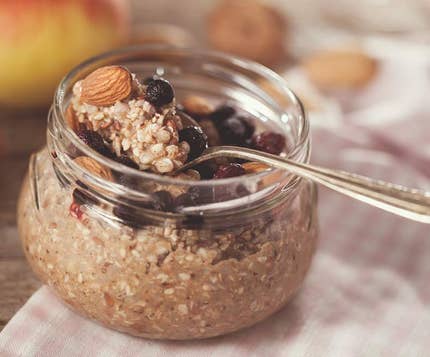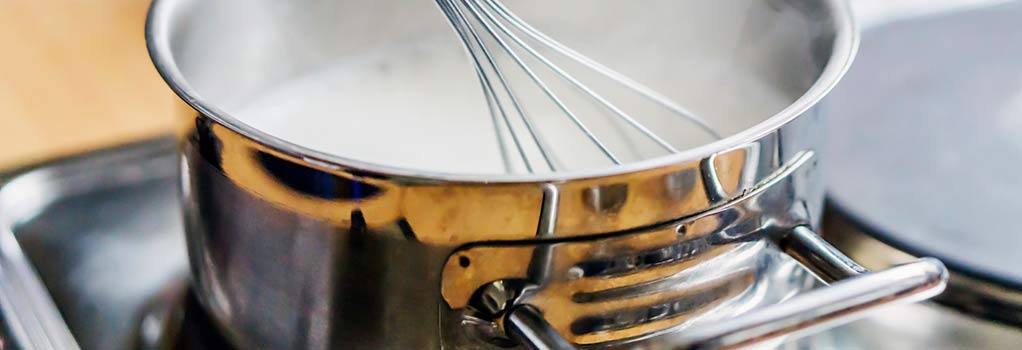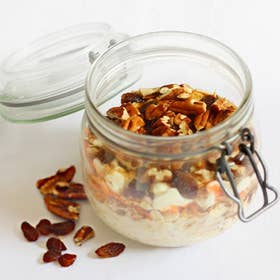How to make perfect creamy porridge oats

Did you know that porridge was one of the first dishes made and eaten by our ancestors? Boiling grains like barley or wheat in water or milk released their nutrients and made them easier to eat, and porridge has been helping us start the day for over 9000 years! Its early origins means oat dishes can be found all over the world. From Northern Europe to South East Asia, sweet or savoury, breakfast or dessert, many cultures have their own take on porridge.
What was once considered a fairly bland dish is being given a make over by some of the world’s top chef’s and has recently had a renaissance in New Zealand.
Porridge is a healthy breakfast option
Why eat porridge oats for breakfast? Well, because Porridge is good for you - possibly one of the most nutritious breakfasts you can eat. Here’s why.
Benefits of eating porridgeOats are a wholefood and are 100% wholegrain with very little added ingredients.The exception is with some instant or sachet oats, which are more processed and sometimes contain artificial flavours or sweeteners. While these sachets are a great option for a quick breakfast, they’re less nutritious than unprocessed oats.Oats contain carbohydrates and fibre, as well more protein and fats than other grains. In just half a cup of dry oats, you’ll find magnesium, copper, iron, zinc, folate, Vitamins B1 and B5. Porridge is up there as one of the most nutrient dense, low calorie breakfasts you can have.
Whole oats are also packed with antioxidants that help lower your blood pressure, lower your cholesterol and even have some anti-inflammatory properties. As a good source of soluble fibre, porridge oats support healthy gut bacteria which is good for digestion and your overall health.TIP: A bowl of porridge makes you feel full for longer, so you’re less likely to snack or overeat during the rest of the day.
What type of porridge is best?
When you’re standing in your local New World comparing bags of oats, you’ll notice there are different varieties. What are the differences between the main types of porridge oats and which are the healthiest?
Wholegrain oats
Also known as ‘old fashioned’ or ‘traditional oats,’ wholegrain oats are steamed and rolled to break down the grains (yes, all oats are wholegrain which can make this a bit confusing).
Wholegrain oats are fairly coarse which gives the porridge a nutty texture. They are less processed than rolled oats so take a little bit longer to cook.
Rolled oats
Rolled oats are finely cut, steamed, and rolled in a press to remove any coarseness which makes them cook quickly.
While the extra processing means rolled oats won’t keep your stomach feeling full for quite as long, they still have the same fibre content as the other oat varieties. Plus, rolled oats have that delicious creamy texture most of us picture when we think of porridge.
Quick oats
Quick or Instant oats are a more processed type of rolled oat that are usually provided as a single-serve in a sachet.Just add water or milk and put it in the microwave. They’re super convenient while still providing minerals, fibre and B vitamins.
While they taste great, be aware that oat sachets may contain added sugar and flavourings so may not be great if you are eating porridge to lose weight or regulate your blood sugar.
Steel cut oats
Much like it sounds, big steel blades are used to slice up the whole oat grains. Because steel cut oats are the least processed, the thicker grains take longer to cook than quick oats or rolled oats. The benefit of this is porridge made from steel cut oats takes more time for your body to digest, so you stay fuller for longer.
So, which oats are the healthiest?
All types of porridge oats are generally nutritious and good for you. As with all foods it is what is added during processing that makes it less good for you. Stick to wholegrain, rolled oats and steel cut oats most of the time and you can’t go wrong. Save the instant oats for when you’re on the run or for your kids!

Millet porridge
One of the earliest grain varieties to be farmed, millet is part of the regular diet for many people in Africa and parts of Asia. Millet porridge has a fluffy texture which makes it stand out from oat porridge.

Rice porridge
Also known as Congee, rice porridge is a staple meal across most of China, and can be made as a sweet or savoury dish for breakfast, lunch or dinner. Rice takes longer to cook than oats, (around 45 minutes to get the right consistency) so it’s not exactly part of a quick and easy breakfast.

Buckwheat porridge
Even though it has ‘wheat,’ in the name, buckwheat is more closely related to quinoa and is gluten free. Buckwheat porridge takes roughly the same amount of time to cook as wholegrain oats so is a good alternative for porridge oats if fancy a change.
1 / 0
Getting the perfect, creamy breakfast porridge
At the risk of sounding a little like Goldilocks, you may have to try a few different cooking methods before you find the porridge that’s just right for you.
Everyone will have a different personal preference and cooking times will depend on your stove or microwave. That said, once you’ve mastered these porridge cooking basics, you’ll have no shortage of delicious, healthy breakfast options.
TIP: You don’t need to wash or rinse oats before you cook them.
Best porridge consistency
We’ve all seen attempts at porridge gone wrong. Not enough water, and porridge becomes thicker and stickier than wallpaper glue. Too much, and porridge becomes a runny, unappetising mess.
The perfect porridge consistency should be creamy, with a smooth, thick base that holds the oats together. Cooked porridge should have just a little al dente bite. Not too chewy, not too soft or bland. That’s when porridge is just right.
Adding water or milk to porridgeThe key to cooking a creamy, delicious porridge is the correct ratio of milk to water. Too much milk will make your oatmeal porridge stickier and thicker. No milk at all and your porridge will lack that creamy taste. Of course, you don’t have to use milk at all if you don’t want to. Water or milk alternatives are fine but your porridge won’t be as creamy just won’t get that creamy texture. The amount of water or milk you need to add will depend on whether you’re using steel cut, wholegrain, rolled or instant oats.
If you’re using rolled oats, use double the amount of liquid per oats. If a serve is half a cup of rolled oats, mix in a cup of water and a splash of milk. You can play around with the ratio of water and milk to oats, just so long as you’re adding double the amount of liquid.The longer your porridge needs to cook, the more liquid you will need to make sure your porridge doesn’t dry out.
Steps for the perfect microwave porridge1. Mix half a cup of rolled oats and a cup of water in a large bowl and microwave on high for 60 seconds. Check and stir. 2. Cook for another 30 seconds, and repeat if necessary until the porridge mixture in your bowl becomes thick and creamy. 3. Carefully take the hot bowl out of the microwave, and add milk and toppings to taste.Of course, this is just a suggestion. As long as you stay close to the magic 2:1 ratio when it comes to oats and liquid, you can play around with a mix of water and milk.
How to make porridge oats in a pot

This is an easy way to make porridge for the whole family. Add oats, water or milk into a pot and put it on the stovetop on a medium heat for ten minutes or so.
The key thing is to cook the porridge low and slow and stir it regularly.
Make sure you stir into the corners of the pot to prevent your porridge sticking to the bottom.
TIP: Don’t let your porridge boil on the stove! First, boiling the porridge will make it stick to the bottom of the pot, and crusted on porridge is nearly impossible to remove. Second, boiling water is one reason why porridge becomes like a sticky glue.
Steps for the best stovetop porridge
- First bring your water to the boil, then set to simmer straight away.
- Add your oats to the simmering water
- For a single serve of half a cup of oats, simmer for around four minutes, stirring occasionally with your spoon or spirtle.
- Stir in a dash of salt before serving into a bowl and finally adding milk and toppings to taste.
If you find the porridge is thickening too quickly on the stovetop, add a little water and mix in to change the consistency. It’s safest to add small amounts of water at a time, because it’s a lot harder to remove the water once it’s been added to your porridge.
How to make porridge oats in the microwave

Quick and easy, you can spend the time you’ve saved in the morning thinking of what toppings to choose. and just as healthy as cooking in a pan. Want to make up a single serving of porridge in a bowl? Half a cup of oats, a cup of water or milk, or even a mix of the two, and put it in the microwave for two minutes. Done. Now you can spend the extra time you’ve saved in the morning thinking of what toppings to choose.
Remember, you can’t regulate the temperature on your microwave like you can with your stove. To make sure your porridge cooks properly and reaches the consistency you like, microwave it in short bursts and check it frequently.
So your porridge doesn’t ‘explode’ make sure you cover it with a plate or paper towel or, better yet, use a microwave-safe container with a lid. Choose a bigger bowl than you think you will need. As porridge cooks in the microwave, it rises and expands. The last thing you want is half of your breakfast spilling across the rotating tray on the bottom of your microwave.!
TIP: Always make sure you use a microwave safe bowl before making porridge in the microwave. If in doubt, cook your porridge in a microwave-safe container, and transfer to a bowl before eating.

Hot choc porridge
For an extra special breakfast, this Hot Choc Porridge stovetop recipe is a favourite with kids and chocolate lovers alike. Adding cinnamon and unsweetened cocoa powder to your porridge as you’re cooking will add that beautiful chocolate flavour without all the added sugar. Add some unsweetened yoghurt and a sliced banana and you’ll think you’re eating dessert for breakfast.
Soaking porridge oats
By leaving your oats soaking in milk, yoghurt, or something yummy overnight, the liquid softens them up in the same way cooking does. Plus, you’ve got a ready-to-eat meal in the fridge as soon as you wake up the next day.
You want to prepare your ‘Overnight Oats’ before going to bed so they are ready to eat in the morning.
Soaking oats in water or milk overnight breaks down the starches that are difficult for our body to digest, without the need for cooking.
Which oats are best for soaking?
The best oats for soaking are whole grain oats. They soak up the liquid overnight, keep their shape and have a lovely creamy texture. Steel-cut oats don’t soak up the liquid as well, rolled oats are okay but quick oats end up being very mushy.

Carrot cake oats
One bonus of overnight oats is that you can add ingredients that would otherwise need valuable cooking time in the morning. If you love carrot cake, you’ll know carrot can be a sweet and tasty addition to baking. Letting the grated carrot soak with your oats in unsweetened yogurt and raisins in a covered bowl in your fridge overnight, breaks down the starches and has a similar effect to cooking them. With this simple Carrot Cake Overnight Oats recipe, you can have a tasty, guilt-free breakfast each morning without the hassle of baking a cake.
Can you eat overnight oats hot or cold?
It’s up to you how you eat soaked oats. Because your recipe has been soaking in the fridge overnight, it will be ready-to-eat and cold. If you feel like warming it up, thirty seconds on high in the microwave just to heat it through will help you get out of bed on a cold winter morning.
Porridge is best eaten fresh and cooked just before serving.
Healthy porridge toppings
Where you need to be careful with porridge oats, however you’ve cooked it, is with your toppings.
Brown sugar or golden syrup are tasty, but will add extra calories added with all that sugar.
A pinch of salt added to your porridge will bring out the flavours. Natural porridge sweeteners include jam, honey and fresh fruit. When it comes to serving and eating porridge, you can add almost anything you like.

Millet porridge
One of the earliest grain varieties to be farmed, millet is part of the regular diet for many people in Africa and parts of Asia. Millet porridge has a fluffy texture which makes it stand out from oat porridge.

Rice porridge
Also known as Congee, rice porridge is a staple meal across most of China, and can be made as a sweet or savoury dish for breakfast, lunch or dinner. Rice takes longer to cook than oats, (around 45 minutes to get the right consistency) so it’s not exactly part of a quick and easy breakfast.

Buckwheat porridge
Even though it has ‘wheat,’ in the name, buckwheat is more closely related to quinoa and is gluten free. Buckwheat porridge takes roughly the same amount of time to cook as wholegrain oats so is a good alternative for porridge oats if fancy a change.
1 / 0
A great start to your day
Porridge is an incredibly versatile breakfast packed with the nutrition your body needs to wake up and focus throughout the morning. How will you make and eat yours? On the stove with milk and chopped banana? Soaked overnight with grated carrot, or in the microwave with frozen berries? However you like your porridge, you’ll find all your ingredients for a healthy, nutritious breakfast at your local New World today.